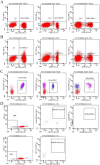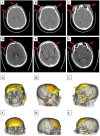Case Report: A novel chemotherapy-free regimen combined with photodynamic therapy, target therapy, and immunotherapy in a geriatric male with huge recurrent scalp and facial angiosarcoma: a report of an extremely rare case and literature review
- PMID: 40364848
- PMCID: PMC12069461
- DOI: 10.3389/fimmu.2025.1556493
Case Report: A novel chemotherapy-free regimen combined with photodynamic therapy, target therapy, and immunotherapy in a geriatric male with huge recurrent scalp and facial angiosarcoma: a report of an extremely rare case and literature review
Abstract
Angiosarcomas are sporadic vascular neoplasms among the most aggressive subtypes of soft tissue sarcomas. In addition, vast and multiple recurrent superficial scalp and facial angiosarcomas are very complex and extremely difficult to manage. Their occurrence brings about significant social and emotional distress to affected individuals. To date, no specific therapeutic strategy has been the most effective and reliable. Herein, we report a highly unique case of a geriatric male patient with recurrent scalp and facial angiosarcoma successfully treated by a chemotherapy-free regimen consisting of photodynamic therapy (PDT), immunotherapy, and target therapy. Notably, PDT provided promising remarkable auspicious outcomes and proved to be a better therapeutic option for refractory malignant angiosarcomas.
Keywords: chemotherapy-free; geriatric patient; immunotherapy; photodynamic therapy; recurrent; scalp and facial angiosarcomas; target therapy.
Copyright © 2025 Maswikiti, Feng, Yin, Zhang, He, Gu, Xiang, Li, Wang, Yu, Xu, Wang and Chen.
Conflict of interest statement
The authors declare that the research was conducted in the absence of any commercial or financial relationships that could be construed as a potential conflict of interest.
Figures





Similar articles
-
Angiosarcoma of the scalp and face: the Mayo Clinic experience.JAMA Otolaryngol Head Neck Surg. 2015 Apr;141(4):335-40. doi: 10.1001/jamaoto.2014.3584. JAMA Otolaryngol Head Neck Surg. 2015. PMID: 25634014
-
The Management and Prognosis of Facial and Scalp Angiosarcoma: A Retrospective Analysis of 15 Patients.Ann Plast Surg. 2019 Jul;83(1):55-62. doi: 10.1097/SAP.0000000000001865. Ann Plast Surg. 2019. PMID: 31192879
-
Angiosarcoma of the head and neck. The UCLA experience 1955 through 1990.Arch Otolaryngol Head Neck Surg. 1993 Sep;119(9):973-8. doi: 10.1001/archotol.1993.01880210061009. Arch Otolaryngol Head Neck Surg. 1993. PMID: 8357598 Review.
-
Treatment and prognosis of angiosarcoma of the scalp and face: a retrospective analysis of 48 patients.Br J Radiol. 2012 Nov;85(1019):e1127-33. doi: 10.1259/bjr/31655219. Epub 2012 Jul 17. Br J Radiol. 2012. PMID: 22806620 Free PMC article.
-
Management of angiosarcoma.Curr Oncol Rep. 2002 Nov;4(6):515-9. doi: 10.1007/s11912-002-0066-3. Curr Oncol Rep. 2002. PMID: 12354365 Review.
References
Publication types
MeSH terms
LinkOut - more resources
Full Text Sources
Medical

